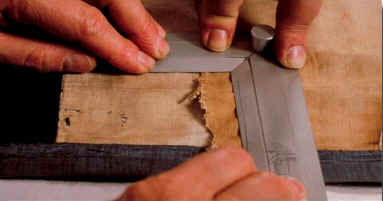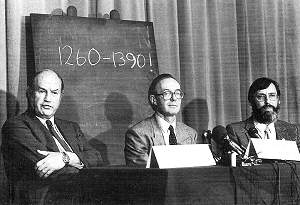SHROUD OF TURIN
PICTURE TOUR WITH DR JOHN DESALVO
PAGE 4 of 5
C14 Tests
In October of 1988 the Shroud was dated using the C14 dating method at three different laboratories. They were the University of Arizona in the US, Oxford University in England, and the Federal Institute of Technology in Zurich, Switzerland. The British Museum supervised the tests.
SLIDE
21 -
Removing a piece of
the Shroud for C14 testing

SLIDE
22 -
Area of the Shroud
where the C14 sample was removed (circled in red on the right slide)
Area in white square on the left side is enlarged to the right.


©1978
Barrie M. Schwortz Collection, STERA, Inc.
SLIDE
23 -
The press conference
which released the results of the C14 dating

The age of the Shroud was dated to 1260 - 1390 AD according to these tests. What does this mean?
As a scientist, if I have 100 data points and 99 are consistent and one is off, I do not just throw away the 99 to accept the anomaly. I would take another look at the inconsistent data point and repeat the test.
Thus it is possible and in fact very likely that the C14 test produced incorrect information.
Here are some reasons why.
1) An unofficial C14 test was done in the 1970ís from one fiber removed from the Shroud. (I was just informed that the test was actually done with a cyclotron in California.) The tests were done on each end of the fiber and produced two different results, 300 AD and 1000 AD. That is one end of the fiber dated to 300 AD and the other end from the same fiber dated to 1000 AD. Thus one fiber gave two different dates. How could this occur? Than we have the 1988 C14 dating giving a date in the 14th century.
2) From the information above the Shroud may be a "Rogue sample", which means that some archeological samples do not lend themselves to C14 dating. No one knows why. For example a Viking Horn was dated to 2006 AD using C14 testing and snail shells still alive dated to be 26, 000 years old. Maybe the Shroud is a Rogue sample and will never give an accurate C14 date.
3) Dr. Garza-Valdes of Texas has proposed a bioplastic coating theory. He has discovered that modern bacteria coat the threads from the Shroud. It has also been demonstrated that the C14 cleaning process does not remove this bacteria and may be the reason why the dating is off. In fact, his calculations show that the amount of bacteria which he finds on the Shroud would throw off the dating by at least 1000 years and bring the date close to the first century.
4) It is possible that the fire of 1532 altered the C12-C14 ratio in the Shroud. The Shroud was sealed in a casket and this would have produced pressure cooker conditions inside. Some preliminary experiments show that this may have changed the C12-C14 ratio.
5) One physicist proposed that the image was produced by a bombardment of neutrons. Where the neutrons came from is unknown. Neutrons would definitely affect the nuclei and change the C12-C14 ratio. Is it possible the image formation process whether neutrons or some other unidentified phenomena affected the C12-C14 ratio?
6) For the 1988 C14 dating tests only one sample was removed and divided up between the 3 labs. Thus, it was one sample not three different ones. In fact it was taken from the side of the Shroud in one of the most contaminated areas of the Shroud. I propose to remove additional samples at several different locations so we have a wider sample basis. Unfortunately, permission has not been granted to do additional C14 testing due to the destructive nature of the tests.
MOST LOGICAL EXPLANATION BY RAY
ROGERS
In my opinion, the best theory put forward to why the C14 dating may be in error was proposed by the late Sue Benford and Joe Marino and confirmed scientifically by Ray Rogers. Ray was a Los Alamos National Laboratory chemist one of the original shroud researcher.
It appears when we look at the shroud there is a side strip on the left that may have been added to it at a later time to center the image. If you notice where the sample was removed, it was right up against this side strip. If indeed this was added at a later time, it was sewn to the main body of the shroud and these fibers would contaminate the original fibers of the cloth. Thus, if a sample was removed from this area, it would have both original shroud fibers and fibers from the reweaving and alter the C14 date. It would look more modern and thus explain the medieval date for the shroud. Ray substantiated this with chemical tests to show that if a side strip was added, it would have to have been dyed to match the color of the main cloth. He found evidence of this. Thus, I think this is the best theory so far explaining the medieval date of the C`14 tests.
SLIDE 24 -
The seam of the side
strip of unknown origin can been seen
running on the left side of the cloth from top to bottom

Thus the reasons above strongly suggest that the C14 test done in 1988 was inaccurate and needs to be repeated with additional samples, better cleaning methods, and more accurate controls.